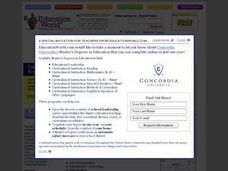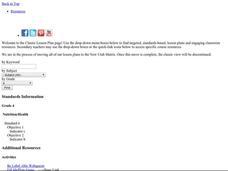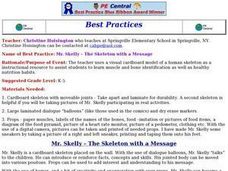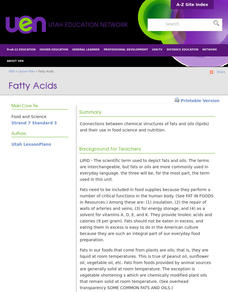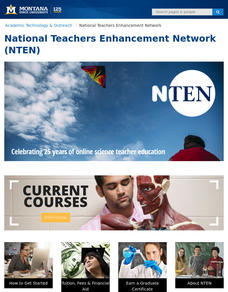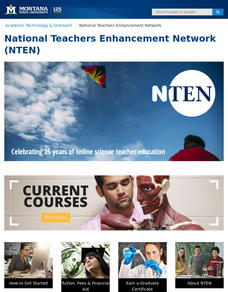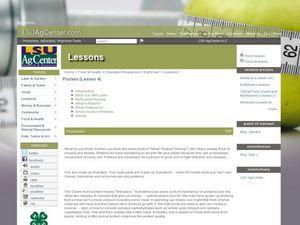Curated OER
Nuts for Peanuts: Peanut Plants, Peanut Timeline, and Peanut-s-timation!
Young scholars complete a timeline. In this peanuts lesson, students read A Short Peanut History and use this resource to make a timeline of the history of the peanut. Young scholars can grow peanuts in the classroom or make various...
Curated OER
What's the Shape of Your Diet?
Fourth graders discover a healthy diet. In this healthy diet lesson, 4th graders compare their typical diet with the recommendations of MyPyramid for Kids.
Curated OER
Rainbow Milk
Learners complete activities to learn about rainbows and the importance of dairy in their diet. In this sense and diet lesson, students discuss rainbow colors, the importance of sight, and the importance of dairy in a healthy diet....
Curated OER
Health: The Skeleton with a Message
Students identify human muscles and bones from a cardboard skeleton, named "Mr. Skelly." Using dialog balloons as props, the teacher holds up advice from Mr. Skelly, such as noting he drinks milk to keep his bones strong. The lesson...
Curated OER
What's on Your Plate?
Students analyze the calorie content of food. In this health science lesson, students discuss how excess calories affect our body. They write a healthy meal plan for their family.
Curated OER
Training Table Race
Students investigate the role of the carbohydrates food group in sports performance. The difference between simple and complex carbohydrates, and the performance of cardiovascular activities form the focus of the lesson.
Curated OER
Fatty Acids
Identify the properties of fats and lipids. Compare the properties of saturated and unsaturated fatty acids Identify foods containing triglycerides and identify which foods contain saturated and unsaturated fat Discuss the function of...
Curated OER
The Human Organism
Students identify their feelings and learn constructive ways of handling conflict. In this human mental health lesson, students identify their feelings, learn how to tell others about their feelings, and learn how to resolve conflict....
Curated OER
FAT FOLLIES
Students, testing various foods for fat content by rubbing food samples on paper. Students identify what and who the US Food and Drug Administration is in reference to the Food Pyramid. Students write the name of each food brought in to...
Curated OER
Science
Students read labels of candy bars. In this ingredients lesson plan, students examine a variety of candy bar labels to determine the contents. Students research to find additional information on each candy bar, then write an...
Curated OER
Stream Quality Assessment
Young scholars investigate many of the factors that affect water quality. They take measurements and water samples at a local stream and evaluate the health of their community's watershed. They write a report detailing their findings.
Curated OER
Should Soil Be Sterile?
Learners determine if the sterilization of topsoil is beneficial to seed germination and plant growth. They grow plants alongside control groups, make and record observations of plant growth and measure plant biomass.
Curated OER
Where's the Beef - Beef Facts or Hype, Is it Bad for You?
Analyze a Happy Meal™ for nutrient content and calories. Blend the contents into "McMush" and use Biuret's solution to test for protein content. There are a few problems with the lesson plan: the resource links are no longer...
Curated OER
A Funky Healthy Life Style!
Students name the five food groups and classify foods according to group. They tell how proteins, carbohydrates, vitamins/minerals, and water help their body. Students discuss how play and exercise can help their body.
Curated OER
Have You had Your *5 a Day*?
Young scholars examine *5 a Day* Dole program to reinforce facts learned about nutrition.
Curated OER
Grocery Store Problem Solving
Fourth graders explore healthy eating habits by viewing instructional videos in class. For this food pyramid lesson, 4th graders identify the different classifications within the food pyramid and identify how they can improve overall...
Curated OER
Rosa Parks Community Garden
Ninth graders investigate how we depend on plants as the original source of most food. They investigate the parts of plants, and which parts are edible. Students are explained that the garden is also a classroom and the same rules apply.
Curated OER
Get the Skinny on Milk
Students identify the different types of milk available in the market. In this adult health science lesson, students compare their nutrition information. They read milk labels and analyze the nutrients in it.
Curated OER
Eggs, Baked Eggs Lab, Day 2
Students examine the structure, sizes and nutritional value of eggs. After completing a word search, they participate in a lab in which they make baked eggs with bacon. To end the lesson, they test their final product and complete a lab...
Curated OER
Eggs, Egg Test, Day 6
Students review their knowledge of eggs, their structure and nutritional value. After the test, they complete an egg lab and turn in their samples to the teacher. To end the lesson plan, they determine their egg score and discuss how...
Curated OER
Mineral Munch
Second graders explore the sodium content in foods they eat. After observing a table setting, 2nd graders then identify items made from rock. They taste low sodium crackers and compare them to regular crackers. Students discuss the...
Curated OER
Coral Reefs Endangered
Students research where in the world coral reefs are located. In this ecology lesson, students create food chains and food web. They simulate growing coral reefs to understand their characteristics better.
Curated OER
Protein
Students examine protein, what it is and how it functions in the body. In this protein activity students study the food pyramid, what a protein is and what it does.
Curated OER
There Are Algae in Your House!
Students demonstrate that, although we sometimes can neither smell nor taste them, many ingredients in our foods and household products come from the sea. They also investigate food eat to determine algae derivatives they contain.
